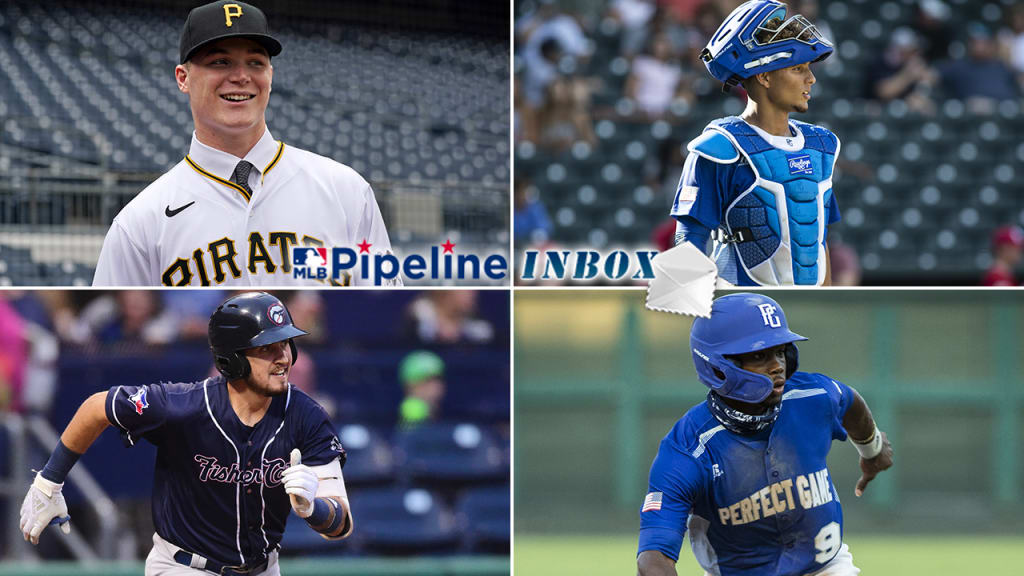
If it's my first Pipeline Inbox after the Draft, that means it's time for an annual question that's one of my favorites, as well as my own self-draft. Let's dive in ...
Time to ask my usual draft question: Which draftees will immediately become their team’s No. 1 overall prospect once they sign?
-- J.P. S., Springfield, Ill.
J.P. started asking me this question years ago when I was writing the "Ask BA" column at Baseball America. We'll overhaul all of our prospects lists in August once the trade and Draft signing deadlines have passed, so this might not all come to pass, but I see six draftees who should ascend to the top of our organization prospect rankings.
Three of them come from the first five picks. Pirates catcher Henry Davis (No. 1 overall) will supplant second baseman Nick Gonzales, Rangers right-hander Jack Leiter (No. 2) will eclipse third baseman Josh Jung and Red Sox shortstop Marcelo Mayer (No. 4) will slot ahead of first baseman Triston Casas and outfielder Jarren Duran. Despite his lofty ceiling, Tigers right-hander Jackson Jobe (No. 3) won't displace corner infielder Spencer Torkelson or outfielder Riley Greene, while Orioles outfielder Colton Cowser (No. 5) has to contend with the best prospect in the Minors, catcher Adley Rutschman.
The other three are all high school shortstops. I'd take Jordan Lawlar (Diamondbacks, No. 6) over outfielder Corbin Carroll, Brady House (Nationals, No. 11) over right-hander Cade Cavalli -- both of those are close -- and Colson Montgomery (White Sox, No. 22) over outfielder Yoelqui Céspedes. A case could be made for another prep shortstop, Khalil Watson (Marlins, No. 16), but Miami has a strong system with multiple options and I'd lean toward right-hander Max Meyer there.
Where do you think Harry Ford ends up? Catcher, second, or outfield? Which one would provide the highest ceiling based on his apparent skill set?
-- @mariners_mojo
The Mariners selected Georgia high schooler Ford with the 12th overall pick in the Draft, and he has stunning athleticism for a catcher. He ran a 6.42-second 60-yard dash at the East Coast Pro showcase last summer and possesses solid-to-plus arm strength, so he could play anywhere on the diamond. One scout drew a parallel between Ford and Hall of Famer Craig Biggio for his theoretical ability to play catcher, second base or center field.
Ford generates a lot of bat speed with his right-handed stroke and has a history of making loud contact against top competition on the prep showcase circuit, so he comes with plenty of offensive potential. His ceiling would be highest if he stayed behind the plate, though that would take a toll on his bat and speed. He has the upside of an All-Star catcher and those are hard to find.
Really intrigued to know what your view is and how you would compare Jordan Groshans vs. Orelvis Martinez? Both seem ticketed for 3rd base, and I have to imagine the Blue Jays end up trading one of them, not necessarily this year obviously.
-- @Wheatz420
The Blue Jays have two outstanding young prospects in Groshans and Martinez, both shortstops who are probably destined for third base. They were both signed in 2018, Groshans for $3.4 million as the No. 12 overall pick in the Draft out of a Texas high school and Martinez for $3.5 million out of the Dominican Republic. Groshans is 21 and batting .289/.369/.446 with five homers in 44 Double-A games, while Martinez is coming off a seven-homer week and is hitting .294/.380/.600 with 17 longballs in 61 contests as a 19-year-old in Low-A.
Because of their difference in age, Groshans is more polished and advanced than Martinez. They have similar offensive potential, with a chance to become plus hitters with power to match, and both have strong arms, but Groshans is quicker and has more range. Toronto already is well-stocked with infielders at the big league level and seven of the first 12 guys on our Blue Jays Top 30 are middle infielders, so they'll have plenty of decisions to make in the next few years.
Who'd you take in your 10-round draft?
-- Jim C., Winnetka, Ill.
That's me asking myself a question as a way to conduct my annual challenge to find players in the Draft while adhering to the same budget constraints that clubs face. I've been making picks through 10 rounds since 2003, never selecting higher than eighth, and my first 18 drafts have generated 52 big leaguers.
My most productive choices have been Jason Heyward, Kyle Freeland, Chris Archer and Kyle Gibson, and my best recent selections include Kyle Lewis, Dakota Hudson, Bryan Reynolds and Brady Singer. My pretend farm system includes Top 100 Prospects Matt Allan, Xavier Edwards and Brett Baty.
This year, I randomly drew the Brewers as my team to shadow, which gave me the 15th overall pick and a supplemental first-rounder. Like Milwaukee, I got a $10,063,400 bonus pool that I can stretch to $10,566,570 without forfeiting future first-round choices.
I went big with North Carolina high school shortstop Khalil Watson at No. 15 and to make sure I could pay him, I took a pair of productive fourth-year bats in the middle rounds (Mississippi State outfielder Tanner Allen, Notre Dame first baseman Niko Kavadas). Watson, Florida outfielder Jud Fabian and Arkansas outfielder Christian Franklin could be steals where I got them, though the latter two come with swing-and-miss concerns.
Here's my draft:
Round: Player, Pos, School (Actual pick)
1st: Khalil Watson, SS, HS/North Carolina (Mia, 1st)
Supp 1st: Jud Fabian, OF, Florida (Bos, 2nd)
2nd: Andrew Abbott, LHP, Virginia (Cin, 2nd)
3rd: Christian Franklin, OF, Arkansas (Chc, 4th)
4th: Tanner Allen, OF, Mississippi State (Mia, 4th)
5th: Grant Holman, RHP, California (Oak, 6th)
6th: Justice Thompson, OF, North Carolina (Cin, 6th)
7th: Niko Kavadas, 1B, Notre Dame (Bos, 11th)
8th: Braden Olthoff, RHP, Tulane (LAA, 9th)
9th: Logan Cerny, OF, Troy (Phi, 10th)
10th: Julian Bosnic, LHP, South Carolina (SF, 16th)
